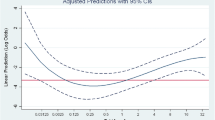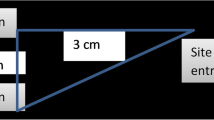Abstract
Purpose
In our clinic, patients with occult breast lesions are treated with a sentinel node biopsy combined with wire-guided tumour excision. The aim of this retrospective study was to determine the influence of the sequence of wire localisation and sentinel node procedure on visualisation of the sentinel node.
Methods
A total of 136 patients had a wire-guided tumour excision combined with a sentinel node procedure. Sixty-six patients had guide wire localisation prior to the sentinel node procedure. Seventy patients had sentinel node visualisation before insertion of the guide wire.
Results
The sentinel node was visualised in 41 (62%) of the patients who first underwent guide wire localisation. In the group of patients who underwent visualisation of the sentinel node before placement of the guide wire, the sentinel node was visualised in 62 (89%). This is a significant difference in visualisation (p<0.001).
Conclusion
This study shows that guide wire localisation prior to the sentinel node procedure negatively influences visualisation of the sentinel node.
Similar content being viewed by others
References
Kopans DB, DeLuca S. A modified needle-hookwire technique to simplify preoperative localization of occult breast lesions. Radiology 1980;134:781
Cabanas RM. An approach for the treatment of penile carcinoma. Cancer 1977;39:456–466
Krag DN, Weaver DL, Alex JC, Fairbank JT. Surgical resection and radiolocalization of the sentinel lymph node in breast cancer using gamma probe. Surg Oncol 1993;2:335–339
Sandrucci S, Casalegno PS, Percival P, Mistrangelo M, Bombardieri E, Bertoglio S. Sentinel lymph node mapping for breast cancer: a review of the literature relative to 4791 procedures. Tumori 1999;85:425–434
Reintgen D, Giuliano A, Cox CE. Sentinel node biopsy in breast cancer: an overview. Breast J 2000;6:299–305
Feldman SM, Krag D, McNally RK, Moor BB, Weaver DL, Klein P. Limitation in gamma probe localization of the sentinel node in breast cancer patients with large excisional biopsy.J Am Coll Surg 1999;188:248–254
Haigh PI, Hansen NM, Qi K, Giuliano AE. Biopsy method and excision volume do not affect success rate of subsequent sentinel lymph node dissection in breast cancer. Ann Surg Oncol 2000;7:21–27
Ege GN, Nold JB, Eng RR, Durakovic A, Conklin JJ. Effects of a metastatic (13762) and nonmetastatic (R3230AC) mammary adenocarcinoma on radiocolloid localisation in regional lymph nodes in Fischer 344 rats. J Reticuloendothel Soc 1983;34:449–462
Chagpar AB, Martin RC, Scoggins CR, Carlson DJ, Laidley AL, El-Eid SE, et al. Factors predicting failure to identify a sentinel lymph node in breast cancer. Surgery 2005;138:56–63
Bergkvist L, Frisell J. Multicentre validation study of sentinel node biopsy for staging in breast cancer. Br J Surg 2005;92:1221–1224
Borgstein PJ, Pijpers R, Comans EF, Van Diest PJ, Boom RP, Meijer S. Sentinel lymph node biopsy in breast cancer: guidelines and pitfalls of lymphoscintigraphy and gamma probe detection. J Am Coll Surg 1998;3:275–283
Heuser T, Rink T, Weller E, Fitz H, Zippel HH, Kreienberg R, et al. Impact of the axillary nodal status on sentinel node mapping in breast cancer and its relevance for technical proceeding. Breast Cancer Res Treat 2001;67:125–132
Pelosi E, Ala A, Bello M, Douroukas A, Migliaretti G, Berardengo E, et al. Impact of axillary nodal metastases on lymphatic mapping and sentinel lymph node identification rate in patients with early stage breast cancer. Eur J Nucl Med Mol Imaging 2005;32:937–942
Yeung HW, Cody III HS, Turlakow A, Riedel ER, Fey J, Gonen M, et al. Lymphoscintigraphy and sentinel node localization in breast cancer patients: a comparison between 1-day and 2-day protocols. J Nucl Med 2001;42:420–423
McCarter MD, Yeung H, Yeh S, Fey J, Borgen PI, Cody HS III. Localization of the sentinel node in breast cancer: identical results with same-day and day-before isotope injection. Ann Surg Oncol 2001;8:682–686
Chok SH, Chow LW, Wong KH, Cheng KC, Ho WY. Breast sentinel lymph node biopsy using radioisotope injection: is one-day better than two-day protocol? Am Surg 2003;69:358–361
Bergqvist L, Strand SE, Persson BBR. Particle sizing and biokinetics of interstitial lymphoscintigraphic agents. Semin Nucl Med 1983;13:9–19
Tanis PJ, Nieweg OE, Valdes Olmos RA, Kroon BBR. Anatomy and physiology of lymphatic drainage of the breast from the perspective of sentinel node biopsy. J Am Coll Surg 2001;192:399–409
Barros A, Cardoso MA, Sheng PY, Costa PA, Pelizon C. Radioguided localisation of non-palpable breast lesions and simultaneous sentinel lymph node mapping. Eur J Nucl Med Mol Imaging 2002;29:1561–1565
De Cicco C, Trifiro G, Intra M, Marotta G, Ciprian A, Frasson A, et al. Optimised nuclear medicine method for tumour marking and sentinel node detection in occult primary breast lesions. Eur J Nucl Med Mol Imaging 2004;31:349–354
Nadeem R, Chagla LS, Harris O, Desmond S, Thind R, Titterrell C, et al. Occult breast lesions: a comparison between radioguided occult lesion localisation (ROLL) vs. wire-guided lumpectomy (WGL). Breast 2005;14:283–289
Acknowledgement
The authors gratefully acknowledge Dr. Barrowclough for critical reviewing our manuscript.
Author information
Authors and Affiliations
Corresponding author
Rights and permissions
About this article
Cite this article
Jansen, J.E., Bekker, J., de Haas, M.J. et al. The influence of wire localisation for non-palpable breast lesions on visualisation of the sentinel node. Eur J Nucl Med Mol Imaging 33, 1296–1300 (2006). https://doi.org/10.1007/s00259-006-0119-1
Received:
Accepted:
Published:
Issue Date:
DOI: https://doi.org/10.1007/s00259-006-0119-1




